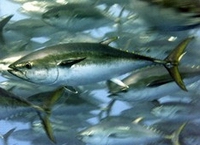
“There have been competing ideas about productivity,” said Ray Hilborn, UW professor of aquatic and fishery sciences. “One is that it depends primarily on abundance. The other is that productivity of a stock mostly depends on whether there’s a period of good conditions or a period of bad conditions.”
Roughly 39 percent of the assessed stocks, the study found, were strongly influenced by “periods of high and low environmental regimes,” while 30 percent “showed a weak relationship between productivity and abundance, mixed in with irregular regime shifts.” The remaining 13 percent, the report found, showed stocks fluctuated randomly.
“Regime shifts can affect the number of young fish that reach adulthood, their ability to grow or how long they live. A shift can be caused by such things as changing ocean temperatures or increases in predators,” said lead author Katyana Vert-pre a UW master’s student in aquatic and fishery sciences.
This does not, the paper’s authors wrote, mean that overfishing is not a factor, or that fisheries managers should stop trying to control overfishing, but understanding patterns of factors that influence fish stock sizes will help with better fisheries management in the future.





